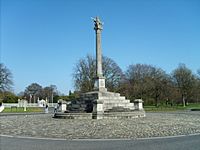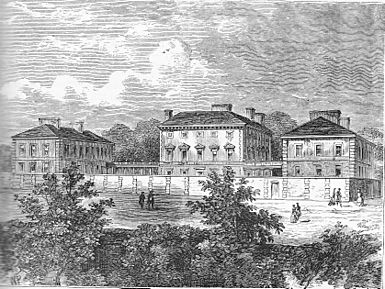Philip Stanhope, 4th Earl of Chesterfield facts for kids
Quick facts for kids
The Earl of Chesterfield
|
|
|---|---|
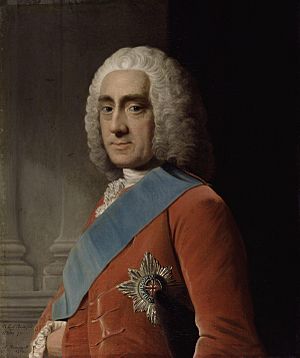
Portrait by Allan Ramsay
|
|
| Secretary of State for the Northern Department | |
| In office 29 October 1746 – 6 February 1748 |
|
| Preceded by | The Earl of Harrington |
| Succeeded by | The Duke of Newcastle |
| Lord Lieutenant of Ireland | |
| In office 1745–1746 |
|
| Preceded by | The Duke of Devonshire |
| Succeeded by | The Earl of Harrington |
| Lord Steward of the Household | |
| In office 1730–1733 |
|
| Preceded by | The Duke of Dorset |
| Succeeded by | The Duke of Devonshire |
| Captain of the Yeomen of the Guard | |
| In office 1723–1725 |
|
| Preceded by | The Earl of Derby |
| Succeeded by | The Earl of Leicester |
| Personal details | |
| Born | 22 September 1694 |
| Died | 24 March 1773 (aged 78) |
| Spouse | Melusina von der Schulenburg |
| Parents | Philip Stanhope, 3rd Earl of Chesterfield Lady Elizabeth Savile |
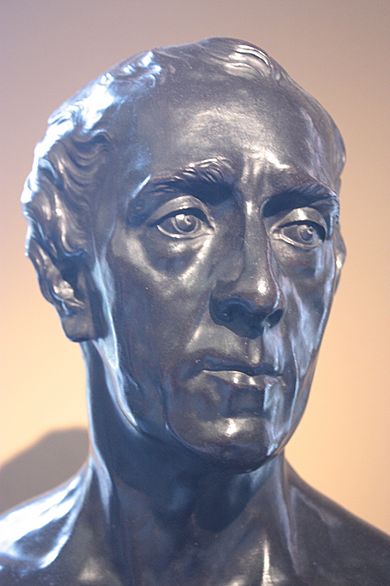
Philip Dormer Stanhope, the 4th Earl of Chesterfield (born September 22, 1694 – died March 24, 1773), was an important British politician, diplomat, and writer. He was known for his cleverness and wit during his time. He held several important government jobs, including Secretary of State and Lord Lieutenant of Ireland. Today, he is best remembered for his famous letters of advice to his son.
Contents
Early Life and Education
Philip Dormer Stanhope was born in London. His parents were Philip Stanhope, the 3rd Earl of Chesterfield, and Lady Elizabeth Savile. Until his father passed away in 1726, he was known as Lord Stanhope. After his mother died in 1708, his grandmother, the Marchioness of Halifax, mostly raised him.
He studied at Trinity Hall, Cambridge, where he focused on languages and public speaking. He left after about a year to go on a "Grand Tour" of Europe. This was a common trip for young noblemen to finish their education. He visited many countries to learn about different cultures and meet other important people.
While he was traveling, Queen Anne died and King George I became king. This opened up chances for Philip to start a political career. He quickly returned to England. He joined the Whig party, a major political group at the time. His relative, James Stanhope, 1st Earl Stanhope, helped him get a job working for the King's son, Prince George.
Political Career Highlights
In 1715, Philip Dormer Stanhope became a member of the British House of Commons, which is like one of the houses of parliament. He was known as Lord Stanhope of Shelford. During one of his first speeches, he was reminded that he was still six weeks too young to speak in the House. He had to pay a fine and left for Europe again.
While in Paris, he sent important information to the British government about a plot by people called Jacobites. When he returned in 1716, he was known as a skilled and polite debater. He became the Captain of the Gentlemen Pensioners in 1723.
Becoming Earl of Chesterfield
In 1726, his father died, and Philip became the 4th Earl of Chesterfield. This meant he moved from the House of Commons to the House of Lords, which is the other house of parliament. His speaking style, which was sometimes seen as too polished in the Commons, was much appreciated in the House of Lords.
In 1728, King George II sent Chesterfield to the Hague as an ambassador. An ambassador is a diplomat who represents their country in another nation. His polite manner and language skills helped him a lot there. For his good work, he received the Order of the Garter in 1730, a special award. He also became Lord Steward, another important government role.
While in The Hague, he helped create the second Treaty of Vienna (1731). This treaty changed alliances in Europe. In 1732, he had a son named Philip with a French governess. Chesterfield later wrote famous letters of advice to this son. Due to illness and money problems, he returned to Britain in 1732.
Marriage and Opposition
In 1733, Lord Chesterfield married Melusina von der Schulenburg, who was the daughter of the late King George I. After getting better from his illness, Chesterfield returned to the House of Lords. He supported Robert Walpole, who was like the prime minister at the time. However, Chesterfield disagreed with Walpole on some issues.
He strongly opposed the "Excise Bill," a tax plan that Walpole wanted. Because of his opposition, Chesterfield was removed from his job as Lord Steward. For the next two years, he led the group in the House of Lords that wanted Walpole to lose power. During this time, he also helped start a new charity in London called the Foundling Hospital, which cared for abandoned children.
In 1741, Chesterfield traveled abroad for his health. He met famous writers like Voltaire and Montesquieu. In 1742, Walpole's government fell, partly due to Chesterfield's efforts. However, Chesterfield was not part of the new government. He continued to oppose King George II, who came to dislike him very much.
Return to Government
In 1743, Chesterfield started writing articles under the name "Jeffrey Broadbottom" to criticize the King and his government. His strong campaign earned him a large sum of money from the Dowager Duchess of Marlborough. In 1744, a new government was formed, which included Chesterfield.
Because of his calm manner and experience, Chesterfield was sent back to The Hague as an ambassador. His goal was to convince the Dutch to join the War of the Austrian Succession. He succeeded quickly. When he returned, he was given the job of Lord Lieutenant of Ireland, a position he had wanted for a long time.
Chesterfield's time as Lord Lieutenant of Ireland (1745–1746) was very successful. He stopped corruption and helped set up schools and factories. He also allowed people in Dublin to visit Phoenix Park, and he put up the "Phoenix Monument" there. He worked to bring peace between different groups in Ireland, and because of his efforts, Irish groups did not join a rebellion in 1745.
In 1746, he became Secretary of State for the Northern Department. However, other politicians worked against him, and in 1748, he resigned from his position. He then spent more time with his books and playing cards.
Later Years and Important Contributions
Even after leaving his main government roles, Lord Chesterfield continued to be involved in the House of Lords. He turned down an offer to become a duke from King George II.
The Calendar Act
In 1751, Chesterfield played a big part in changing Britain's calendar. Working with scientists, he helped pass the Calendar (New Style) Act 1750. This act officially adopted the Gregorian calendar for Britain and its colonies. This meant the year would start on January 1st, just like it does today. This act is sometimes called "Chesterfield's Act." As he got older, he started to withdraw from politics and social life because he was losing his hearing.
Dispute with Samuel Johnson
In 1755, Chesterfield had a disagreement with the famous writer Samuel Johnson. Eight years earlier, Johnson had asked Chesterfield for support for his big project, A Dictionary of the English Language. Chesterfield had given him some money. However, Johnson felt that Chesterfield hadn't shown enough interest during the dictionary's creation.
When the dictionary was about to be published, Chesterfield wrote two articles praising Johnson's work. But Johnson was still upset and wrote a strong letter to Chesterfield. This letter explained how he felt about patrons (people who support artists). Chesterfield was not offended by the letter. Instead, he was impressed by Johnson's writing and showed the letter to visitors, saying, "This man has great powers."
Views on the Stamp Act
In the 1760s, Chesterfield spoke out against the Stamp Act 1765. This was a tax law passed by the British Parliament that angered the American colonies. Chesterfield thought the tax was a bad idea because it would be hard to enforce. He also believed that the money it would bring in was much less than the money Britain would lose from reduced trade with the colonies.
Letters to His Son
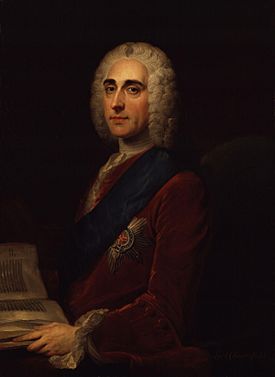
After Chesterfield's illegitimate son, Philip Stanhope, died, his widow, Eugenia Stanhope, published a book called Letters to His Son on the Art of Becoming a Man of the World and a Gentleman (1774). This book contains over 400 letters that Chesterfield wrote to his son over 30 years.
He started writing these letters in 1737 and continued until his son's death in 1768. The letters gave advice on many topics, including geography, history, and classic literature. Later letters focused on politics and diplomacy. Chesterfield wrote them in French, English, and Latin to help his son learn these languages.
Even though Chesterfield was a well-known writer during his life, his most famous works today are these private letters. He never intended for them to be published.
Succession and Legacy
In 1768, Chesterfield's son, Philip, died. Philip had two sons, Charles and Philip, who were born outside of marriage. Chesterfield was sad about his son's death and also disappointed that Philip had married a woman from a lower social class. However, he left money for his grandsons.
Since Chesterfield and his wife had no children together, he needed an heir for his titles and property. He adopted his distant cousin and godson, also named Philip Stanhope, to become the next Earl of Chesterfield.
Death
Philip Dormer Stanhope, the 4th Earl of Chesterfield, died on March 24, 1773. He passed away at Chesterfield House, his home in London. His adopted heir then became the 5th Earl of Chesterfield.
Legacy
In Literature
Lord Chesterfield appears as a character in the novel The Virginians (1857) by William Makepeace Thackeray. He is also mentioned in Charles Dickens' novel Barnaby Rudge (1841). In that book, a character named Sir John Chester says that Lord Chesterfield is the best English writer.
Places Named After Him
In the UK, Chesterfield Street in London is named after him. In the US, Chesterfield County, Virginia, and Chesterfield County, South Carolina, also carry his name.
Furniture
It is believed that the first leather Chesterfield sofa was made for Lord Chesterfield. This type of sofa has deep buttons and a quilted leather look, with arms and a back of the same height. In the UK, the word chesterfield now describes this kind of sofa. In Canada, the word chesterfield used to mean any type of couch.
Other Connections
- Chesterfield cigarettes were named after Chesterfield County, Virginia, which was named for him.
- Vincent La Chapelle, a famous French chef, worked for Lord Chesterfield and wrote a cookbook called The Modern Cook.
- Chesterfield coats are woolen overcoats with velvet collars, known for their elegant style.
- D. G. Yuengling & Son makes a beer called Lord Chesterfield Ale named after him. There is also a Chesterfield Road in Pittsburgh.
See also
 In Spanish: Philip Stanhope (4º Conde de Chesterfield) para niños
In Spanish: Philip Stanhope (4º Conde de Chesterfield) para niños


